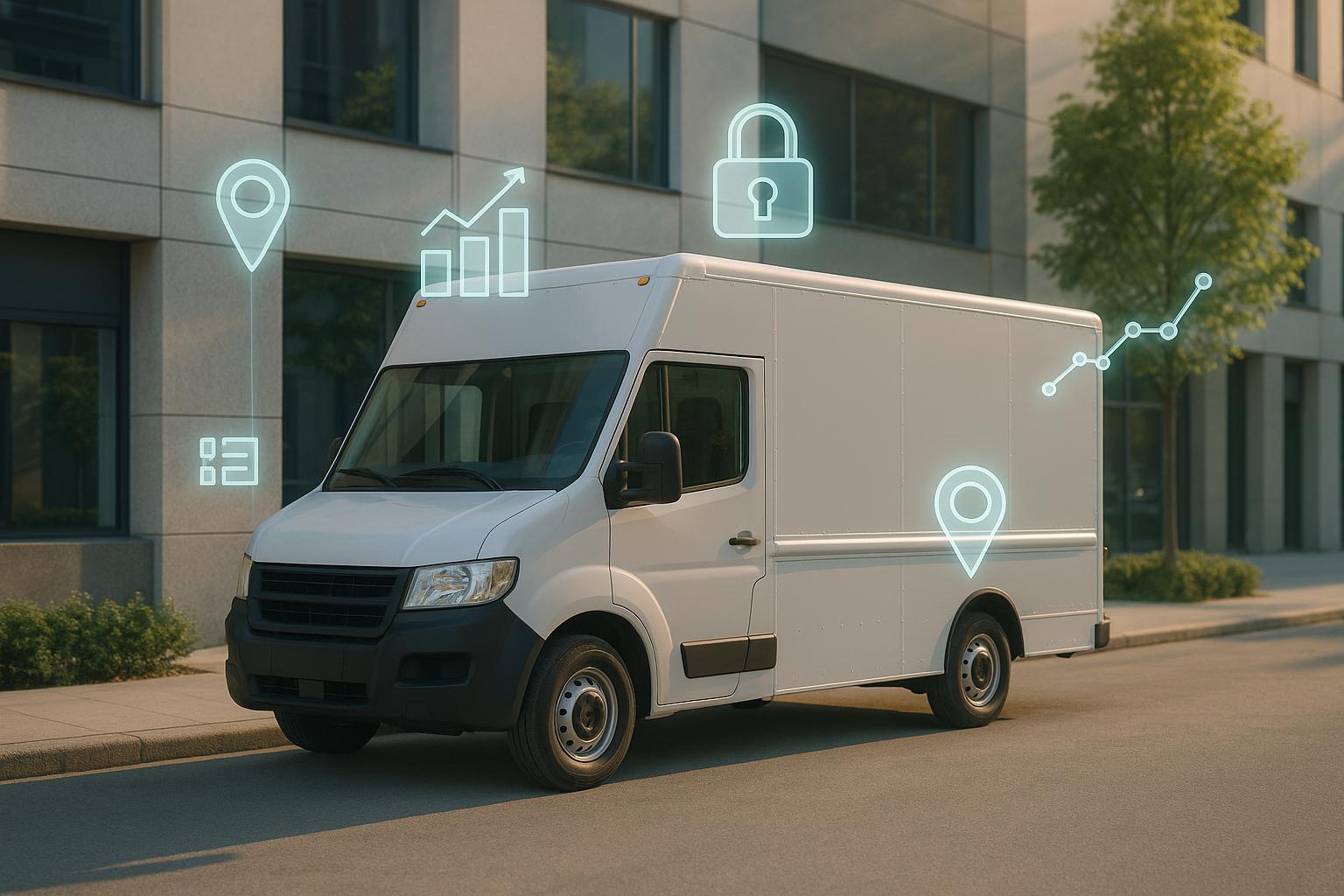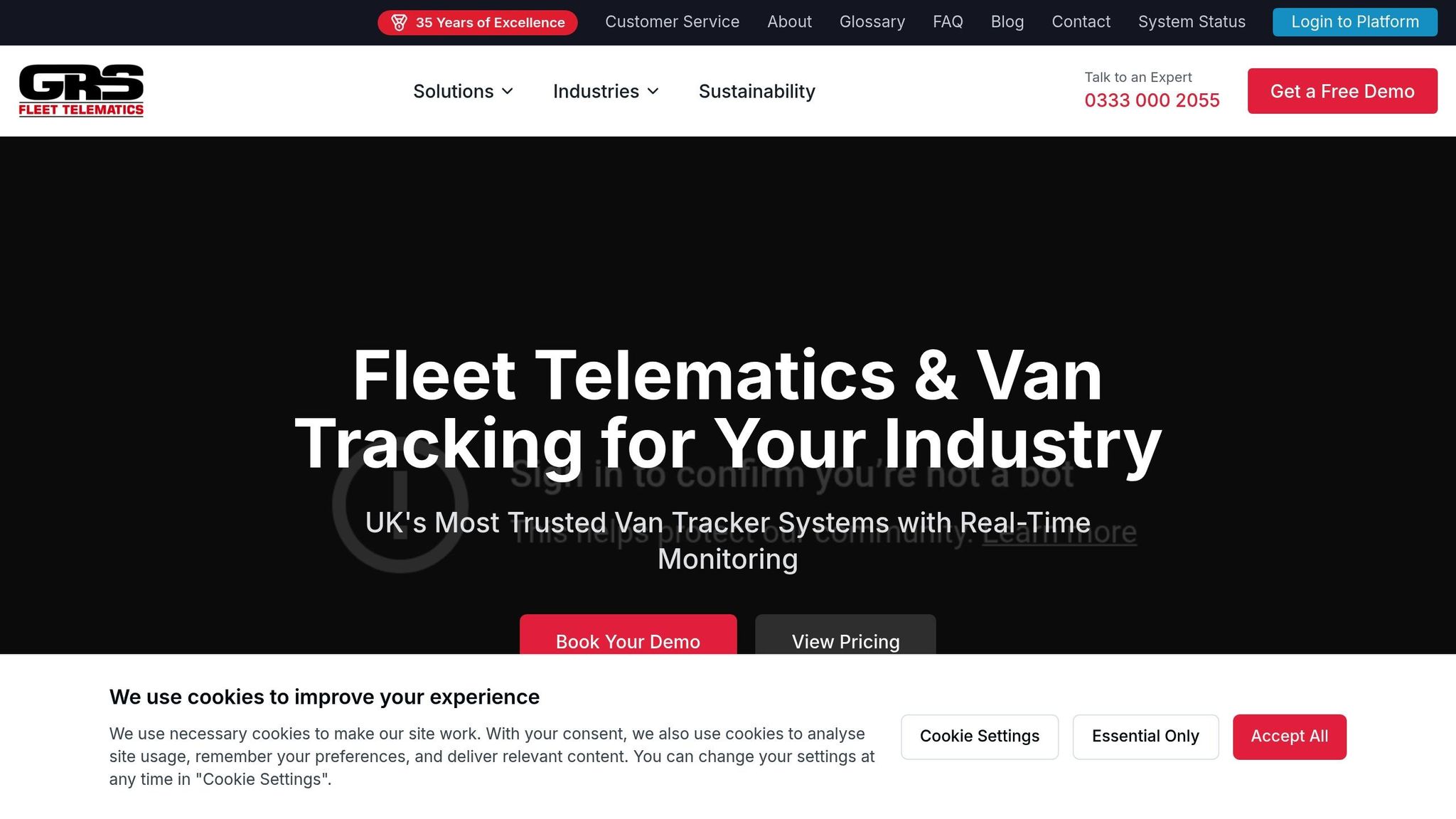Fleet Telematics and Data Privacy: Best Practices
Explore essential practices for fleet telematics and data privacy compliance, balancing efficiency with driver trust and legal requirements.

Fleet telematics systems are powerful tools for managing vehicle fleets, offering features like GPS tracking, route optimisation, and driver behaviour monitoring. However, they collect sensitive data, such as location and driving habits, which makes data privacy a key concern. Businesses in the UK must comply with strict regulations like GDPR, ensuring consent, transparency, and secure handling of data to avoid hefty fines and maintain trust.
Key points for fleet operators:
- Consent and transparency: Inform drivers about data collection and use.
- Limit data collection: Only gather what's necessary for business needs.
- Secure storage: Encrypt data and control access with role-based permissions.
- Comply with laws: Follow GDPR, UK employment laws, and surveillance guidelines.
- Regular audits: Review and update privacy practices to remain compliant.
Modern telematics systems, like those from GRS Fleet Telematics, incorporate features such as encrypted data transmission, secure cloud storage, and privacy-by-design principles. These solutions help businesses balance efficiency with compliance, starting at £7.99 per vehicle per month.
How To Manage Data Privacy Risks With Telematics? - Talking Tech Trends
Data Privacy Laws for Fleet Telematics
Fleet operators in the UK face strict legal guidelines when using telematics systems. These rules are shaped by European data protection standards and specific UK employment and surveillance laws. Together, they set clear boundaries on how businesses can collect, use, and store vehicle tracking data.
Meeting these requirements not only ensures compliance but also helps build trust with drivers and shields your business from potential data breaches. Below, we delve into the key obligations under GDPR and other UK-specific laws.
GDPR Requirements for Telematics
The General Data Protection Regulation (GDPR) remains a key piece of data privacy legislation in the UK, even after Brexit. When it comes to fleet telematics, GDPR outlines six core principles that influence how tracking systems should operate.
Lawfulness and transparency demand that fleet operators establish a clear legal basis - usually legitimate interests - and document the reasoning. Data collection must be limited to what’s necessary. For instance, if you’re tracking vehicles to optimise routes, recording personal conversations or monitoring break locations without a valid operational reason would breach this principle. Many telematics systems collect more data than needed by default, so this is a critical area to monitor.
Purpose limitation dictates that data collected for one reason cannot be reused for another without proper procedures or additional consent. For example, data gathered for route management cannot suddenly be used for disciplinary action unless explicitly agreed upon.
Accuracy and storage limitation require operators to keep data up to date and delete it when it’s no longer needed. Telematics systems often gather large amounts of historical data, but GDPR makes it clear that this information must not be kept indefinitely. In most cases, retaining detailed location data beyond 12 months is unnecessary unless specific legal or insurance requirements apply.
To comply, fleet operators should document their processes, maintain records of data processing, conduct privacy impact assessments, and carry out regular audits. These steps are essential for maintaining both legal compliance and driver trust.
UK Fleet Tracking Laws
In addition to GDPR, UK-specific laws provide further guidance on vehicle tracking practices. Employment laws, in particular, add another layer of complexity when monitoring workers through telematics systems. The Employment Rights Act 1996 and the Human Rights Act 1998 protect workers' rights to privacy, even during work hours.
Covert monitoring is heavily restricted under UK law. The Information Commissioner’s Office (ICO) states that secret tracking is only permissible in exceptional cases, such as investigating criminal activity. Routine fleet management doesn’t meet this threshold, so drivers must always be informed about tracking systems before they are deployed.
Tracking should be necessary and proportionate to business needs. Courts have ruled that constant location monitoring may be excessive for certain roles. For example, tracking should focus on essential routes rather than monitoring employees during off-duty periods.
The Working Time Regulations 1998 also come into play when telematics is used to log working hours. If your system records when drivers begin and end their shifts, this data becomes part of working time records and must comply with rules around accuracy and retention.
If tracking systems affect working conditions - such as influencing performance reviews, route assignments, or disciplinary actions - trade union consultation may be required under the Trade Union and Labour Relations (Consolidation) Act 1992.
UK courts have also ruled that tracking data can qualify as personal data. Combining location information with time stamps can create detailed profiles of individual behaviour, which demands additional safeguards. The Court of Appeal’s ruling in Vidal-Hall v Google confirmed that even seemingly anonymous location data could identify individuals when combined with other information.
Lastly, the Protection of Freedoms Act 2012 regulates surveillance activities, including vehicle tracking systems that monitor driver behaviour. While this law primarily focuses on CCTV, its principles extend to any systematic monitoring of individuals, making it relevant for fleet operators using telematics.
Data Privacy Best Practices Checklist
Protecting data privacy in fleet operations requires a structured approach with actionable steps. Fleet operators must balance safeguarding driver information with maintaining operational efficiency. This checklist outlines key measures to integrate privacy into your telematics systems, building on legal requirements and earlier discussions to secure your data.
Get Driver Consent and Set Clear Policies
Clear communication is the backbone of any compliant tracking programme. Before monitoring begins, make sure drivers fully understand what data is being collected, why it’s needed, and how it will be used. This transparency not only ensures legal compliance but also fosters trust.
Draft a detailed privacy policy that explicitly states what data will be monitored - such as location, speed, idling time, and trip logs - and limit tracking strictly to work hours and activities. Avoid ambiguous phrases like "we may collect operational data" and instead list every data point explicitly.
Hold team meetings to explain the system, answer questions, and give drivers enough time to review and understand the privacy policy. This ensures their consent is truly informed.
Regularly update your privacy policies to reflect changes in technology or regulations. If new tracking features are added or data collection practices shift, update the policy accordingly and obtain fresh consent from drivers for expanded monitoring.
Limit Data Collection and Control Access
Minimising data collection reduces privacy risks and makes compliance simpler. Only gather the information essential for your operations. Regularly review your data collection practices to confirm that all collected data serves a clear business purpose.
Implement strong security measures like two-factor authentication and role-based access controls, ensuring employees can only access data relevant to their responsibilities. This limits unnecessary exposure and enhances security.
Encrypt data both at rest and during transmission. Verify that your provider uses industry-standard encryption protocols to protect sensitive information. Additionally, set up alerts to detect unusual activities, such as large-scale data downloads or access outside normal business hours.
Conduct Security Audits and Enable Privacy Features
Routine reviews are critical for maintaining robust data protection. Conduct regular access reviews to ensure permissions align with current job roles, especially as team responsibilities evolve.
Adopt a privacy-by-design approach when developing or updating fleet systems. Evaluate the privacy implications of new telematics features and prioritise those that enhance operations without increasing data collection unnecessarily.
Perform periodic audits to confirm that your privacy practices align with your policies and meet regulatory standards. These audits help identify gaps and ensure your fleet's data privacy measures remain effective and compliant.
Data Handling and Storage Protocols
Effective data handling and secure storage are the backbone of compliance in fleet telematics systems. These practices help safeguard sensitive information and ensure adherence to GDPR regulations. Two critical components of this process are encryption and access controls.
Data Encryption and Access Controls
Fleet data should always be encrypted - both during transmission and while in storage - to prevent unauthorised access to sensitive information [2]. When transferring data between systems, use a secret key sent through a separate, secure channel to maintain security. Additionally, implement strict role-based access controls to ensure that only personnel with the appropriate authorisation can access confidential data. This layered approach strengthens overall data protection.
Security Features in Van Trackers
Van trackers are designed to protect sensitive information and respect driver privacy. By incorporating multiple security layers, these systems ensure the safety of business data and personal information throughout the entire data lifecycle. Let’s take a closer look at how these security measures enhance van tracking.
Privacy by Design in Tracking Solutions
The concept of privacy-by-design means data protection is built into the system from the very beginning, rather than being added as an afterthought. Features like driver privacy mode allow employees to switch off tracking outside working hours, aligning with UK regulations and supporting personal privacy. Additionally, dual-tracker technology ensures the system remains operational even if one component is compromised. To further enhance security, end-to-end protocols safeguard data at every stage of its lifecycle.
Compliance with GRS Fleet Telematics

Building on encryption and access controls, GRS Fleet Telematics takes security to the next level, meeting both GDPR and UK privacy standards. Van trackers on this platform utilise secure cloud storage and enforce strict role-based access controls to protect fleet data. The system also supports data minimisation principles, offering customisable settings for data collection, retention periods, and automated deletion schedules.
This approach ensures fleet operators can maintain strong data protection while adhering to privacy regulations. GRS Fleet Telematics offers these robust security features across all service tiers, with subscriptions starting at £7.99 per vehicle per month. This makes enterprise-grade data protection accessible to fleets of all sizes, ensuring compliance without compromising on security.
Conclusion: Data Privacy in Fleet Management
Fleet telematics systems handle a wealth of sensitive information, making data security a top priority for building driver trust and staying compliant with UK privacy regulations. As these systems evolve, maintaining strict adherence to privacy laws is not just a legal necessity but also a way to foster transparency and accountability.
Key Points for Fleet Operators
For fleet operators, safeguarding data privacy is an ongoing responsibility, not a one-time task. Here are some essential practices to prioritise:
- Secure driver consent: Always obtain clear and informed consent from drivers, supported by transparent and regularly updated privacy policies.
- Conduct regular audits: Routine security checks help identify and fix vulnerabilities before they become larger issues.
- Limit data collection: Use data minimisation techniques and enable privacy modes, particularly during off-duty hours, to respect drivers' personal time.
By focusing on these areas, fleet operators can strike the right balance between operational needs and protecting individual privacy.
Advanced Solutions for Enhanced Compliance
Taking it a step further, modern telematics systems are designed with privacy and security in mind. Features like privacy-by-design architecture, end-to-end encryption, and role-based access controls ensure compliance with regulations such as GDPR. These tools not only protect sensitive data but also simplify compliance management.
For example, GRS Fleet Telematics offers a practical solution for fleets of all sizes. At just £7.99 per vehicle per month, it combines enterprise-grade data security with user-friendly fleet management tools, making robust protection accessible even for smaller operators.
The future of fleet management lies in solutions that integrate security, compliance, and operational efficiency. By prioritising driver privacy and safeguarding business data, fleets can boost trust and productivity while meeting the ever-evolving standards of modern data privacy.
FAQs
How can fleet operators stay GDPR-compliant when using telematics systems?
To stay in line with GDPR requirements, fleet operators must secure clear and explicit consent from drivers before gathering any personal data. Equally important is putting robust data security measures in place to protect this information and ensuring transparent policies detail how the data will be handled and used.
It’s also crucial to regularly assess how data is managed and to provide staff with GDPR training. These steps not only safeguard drivers’ privacy but also ensure businesses comply with legal standards, helping them avoid fines under UK data protection laws.
What could happen if fleet operators in the UK fail to comply with data privacy laws?
Non-compliance with UK data privacy laws can result in hefty penalties, including fines of up to £17.5 million or 4% of a company’s annual global turnover - whichever is greater. But the consequences don’t end there. Businesses may also face operational restrictions, legal battles, and reputational harm, all of which can undermine customer trust and disrupt daily operations.
To steer clear of these risks, fleet operators must ensure their telematics systems are designed with data security at the forefront and adhere to regulations like GDPR. By putting strong privacy measures in place, you not only safeguard your business but also build trust with clients and stakeholders.
How can businesses ensure data privacy while maintaining efficiency in fleet telematics?
To keep fleet telematics efficient while respecting data privacy, businesses should focus on implementing clear and transparent data policies. Make it a priority to inform drivers and staff about the specific data being collected, its purpose, and the steps being taken to protect their privacy. This openness not only builds trust but also ensures alignment with UK data protection regulations.
It’s also wise to invest in privacy-conscious telematics solutions. These systems should provide the operational insights you need without venturing into unnecessary personal data. Opt for platforms equipped with strong security measures like encryption and access controls to guard against unauthorised access. Balancing privacy with operational efficiency allows businesses to streamline fleet management while honouring the rights of employees and customers alike.
